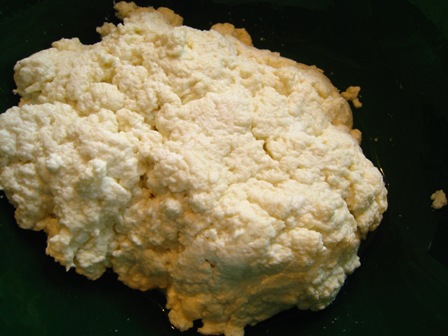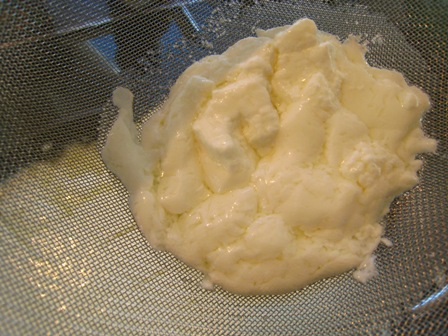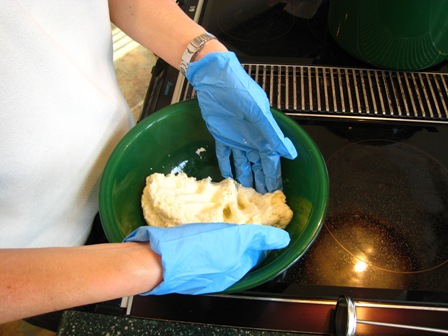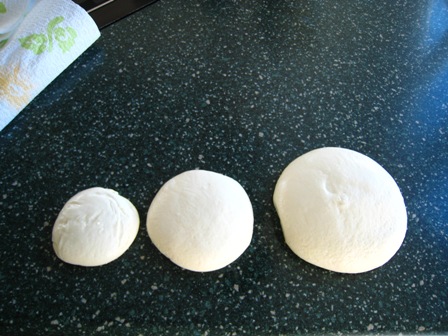CURDS OUR WHEY – MONTH 1 – 30 MINUTE MOZZARELLA

Today is the first post of a new group I belong to – “Curds Our Whey”. A group of us from the Food Forum on Slow Travel Talk decided we were interested in making home-made cheese. I decided to take the lead on this and plan the logistics of this group-what cheeses we would make, what ingredients we needed, etc.
The book we decided to use for our recipes is Home Cheese Making by Ricki Carroll. You can order this book from Amazon, purchase it at your local bookstore, or order from Ricki’s website at New England Cheesemaking SupplyCompany. I ordered all of my supplies from New England Cheesemaking Supply Company.
I knew the first cheese we had to make was the 30 Minute Mozzarella. How exciting to have fresh mozzarella in 30 minutes. I was skeptical and didn’t think it could be done, but I was luckily proven wrong.
The ingredients in the cheese are pretty simple-pasteurized whole milk, citric acid, lipase, rennet, and cheese salt. You bring the milk to 55 degrees F., then mix in the citric acid and lipase. You then heat the milk to 90 degrees F, and stir in the rennet. Then you let it sit for a few minutes, and then cut the curds into squares. You then scoop out the curds with a slotted spoon and put into a bowl.
This is what the curds looked like the first time I made the cheese. They were dense enough, but didn’t form where I could cut them into 1″ squares. I think I may have stirred the solution too much after adding the rennet.
This is the curds the second time I made the cheese. This time I only stirred about 10 seconds after adding the rennet, then let the mixutre set about 8-10 minutes.
This photos shows a closeup of the drained curds. They were nice and firm the first time I made the cheese, even though the curds didn’t form into a solid mass that could be cut.
The second time I made it, even though the curds could be cut, they were much softer than the first attempt. I think that not as much whey had drained out of them.
After the whey is drained off the curds, the mixture is heated up in the microwave and then kneaded. This process happens a few times.
When the cheese is smooth and elastic and stretches like taffy, you roll it into balls.
This photo shows a closeup of the texture of the cheese.
It is hard for me to give you hints about making this cheese. I have made it 3 times now. Each time the process has given me different results during the process, but the finished product has turned out similar. A couple of hints I do have-don’t overknead. It can make the cheese a little too firm. The first attempt, my cheese also seemed a little drier, so I didn’t drain off as much whey the next time. Also, make sure and use milk that tastes good. The flavor comes through. And lastly, I would make sure and use the full amount of salt. It needs the salt, or it doesn’t have any flavor.
The last thing I’ll say is that I don’t think the cheese stores well at all. I tried storing it in whey, plain water, and just wrapped in plastic wrap. After a day, it gets a weird texture. So plan on eating it fresh, and to make it extra-special, make a Caprese Salad. Layer the sliced mozzarella with sliced tomatoes and basil leaves, drizzle it all with extra-virgin olive oil, and if desired, balsamic vinegar, and freshly ground pepper and salt. And be sure and have a loaf of crunchy crusty bread along with it. YUM!!!
*Note: I’ve decided not to post the recipe here. You’ll have to order the supplies you need, and you’ll probably want to order ingredients for more than one type of cheese, so I would recommend purchasing the book we’ve used or another book with cheese recipes.









Cindy, I love the texture of your Mozzarella. I was never fully satisfied with the texture of mine, but now I see the second time you made, it looks very shiny! I never got that. I plan on keep making it, until it works though.
Great job, and thanks again for taking the reins on this. I am enjoying it.
Wow, you Curds and Whey peeps are impressive.
I am also behind, and will make mozzarella in April, along with the next selection!
No problem Palma. We look forward to having you join us next month.
Oh I just love mozzerella like this!
Thanks Candi-your mozzarella looks great too (as does that pizza!)
Thanks Barb. It’s fun.
Michelle-you should try it. It’s not too difficult, and it’s a fun process.
Soooo delicious-looking!
I was going to do this, and fell so far behind…:-(
I’m so impressed. That salad is absolutely beautiful!
I knew I was going to have fun doing this one vicariously – looks pretty darn good from where I sit.
Very impressive! It looks so perfect in the photo with the tomatoes.
I am so impressed! I never even thought about it being possible to make homemade mozzarella cheese before seeing your earlier caprese salad post and now this post. I look forward to seeing the other cheeses you make.
I am really impressed! Looks good enough to eat.
I bought a kit from Ricki’s website for the mozzarella. I had much the same results my first and second try. I also have made cheddar cheese from another kit I purchased from her site. I had a test tasting with colleagues at work and they all loved it. It is amazing how the littlest thing can effect how the curds come out. I also have only used store bought milk as I have little access to raw milk. Good luck in you future ventures.
That is pretty impressive I must say. I have yet to try it but being a foody I might have to make a few attempts at it. That’s great because not only do you get great fresh mozzarella but you get fresh whey too which is one of the best proteins you can give your body.
You should try throwing the whey into a shake. I take them every. Here’s an article I just wrote for some recipes on great whey protein shakes you should try out. Let me know what you think.